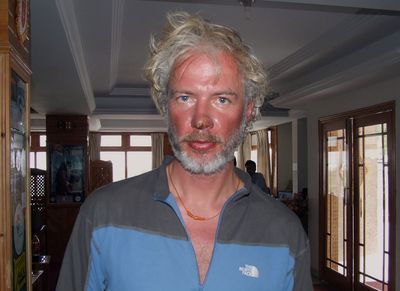K2 survivor tells of panic
Avalanche left nine dead

ISLAMABAD, Pakistan – A Dutch survivor of an ice avalanche that killed nine climbers atop the world’s second-tallest mountain over the weekend described a desperate scramble for self-preservation, with panicked mountaineers abandoning one another in the search for a way down the steep rock face.
Some victims were swept away by a column of ice that snapped near the summit of K2 in northern Pakistan near the Chinese border, widely regarded as the world’s most treacherous peak. The falling pane of ice severed fixed ropes used mostly for descending near-vertical portions of slopes, leaving other climbers cut off at an oxygen-thin elevation known as the “Dead Zone.”
“People were running down but didn’t know where to go, so a lot of people were lost on the mountain on the wrong side, wrong route, and then you have a big problem and then things like that happen,” said Wilco Van Rooijen, the leader of one expedition, in an interview with Reuters news agency from his cot in a Pakistani military hospital.
Two other climbers fell to their deaths on the way up the mountain, making this the deadliest year on K2 since 1986, Pakistani officials said.
Van Rooijen was one of two Dutch climbers rescued after the accident. He slept two nights on K2 without a sleeping bag, food or water, but was plucked from the mountain by a helicopter after making his way down from the icy upper reaches of the pyramid-shaped peak.
He described passing three South Korean climbers who chose to wait for rescuers and are believed to be among the dead. Other climbers fell to their deaths while trying to cross the gully where the safety ropes had been severed, according to a spokesman for the Dutch expedition who had been in contact with Van Rooijen by satellite phone.
News reports also said at least some of the trapped climbers froze to death after being forced to spend the night near the top of a peak that rises more than 28,250 feet.
The accident occurred after nightfall in a perilous gorge known as the “Bottleneck,” the last major obstacle on the way to the summit. Climbers became scattered and scrambled to save themselves, Van Rooijen said, a scene eerily reminiscent of the 1996 catastrophe on Mount Everest that killed eight climbers in a tragedy described in Jon Krakauer’s best-selling book, “Into Thin Air.”
Van Rooijen, 40, who had attempted K2 twice before, said climbers ignored his pleas for calm.
“They were thinking of using my gas, my rope,” he said. “Everybody was fighting for himself, and I still do not understand why everybody were leaving each other.”
Most of the victims were experienced climbers. Rolf Bae, a Norwegian believed swept away in the avalanche, was climbing with his wife, Cecile Skog. The couple are renowned polar explorers and were making their second attempt on K2.
Skog reportedly was descending the mountain.
While most of the people on K2 were believed to be highly experienced, some survivors questioned the judgment of fellow climbers. Van Rooijen said some ropes had been laid improperly across a gully and required laborious repositioning. Delays meant some teams reached the summit after 8 p.m., requiring them to descend in the dark, a far more dangerous undertaking.
Ed Viesturs, who has conquered K2 and recently concluded a successful 16-year quest to scale all 14 of the world’s 8,000-meter peaks, said in an interview that K2 is considered “the Holy Grail of mountains.”
Viesturs said K2 is considered more difficult than the slightly higher Mount Everest because the peaks are steep and difficult to climb from all approaches, and because its weather is “unpredictable and often unrelenting.”
But the technical challenges are seductive for professional climbers, who often take risks on K2 that they might not otherwise accept on other climbs, Viesturs said.
The dead mountaineers came from several countries, according to the head of Pakistan’s tourism ministry. They included three Koreans, two Nepalis, two Pakistani porters, French, Serbian, Norwegian and Irish climbers.
Marco Confortola, an Italian, appeared to have survived the ice fall although he remained on the mountain Monday. Suffering from exhaustion and severely frost-bitten feet, he was assisted down the mountain by porters and was awaiting rescue helicopters.
The deadliest year on K2 was 1986, when 14 climbers perished, including 13 during a single storm. The mountain has claimed more than 75 lives overall, and several bodies remain entombed on its snowy slopes.